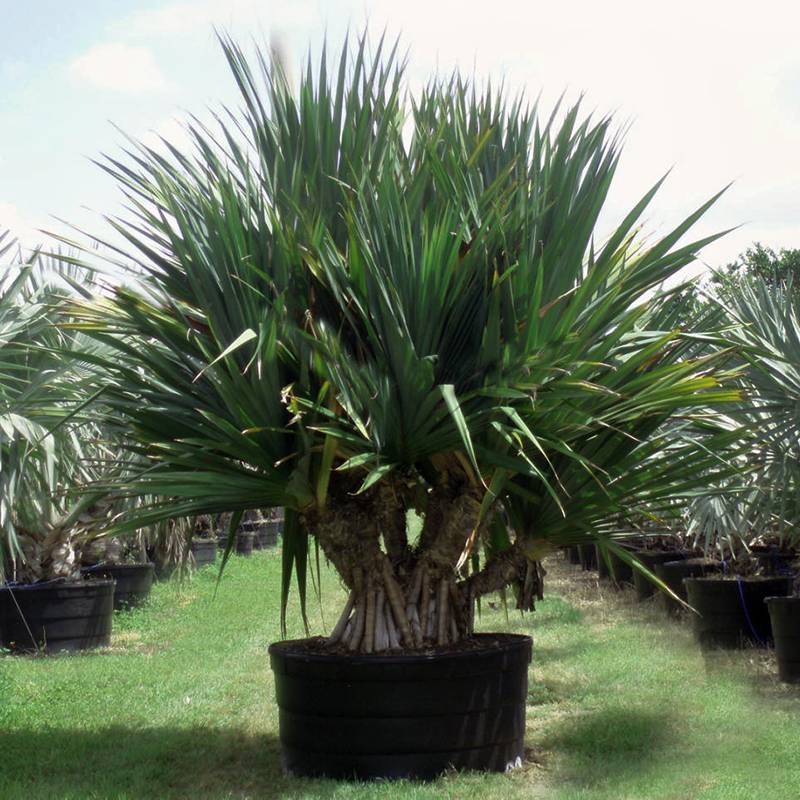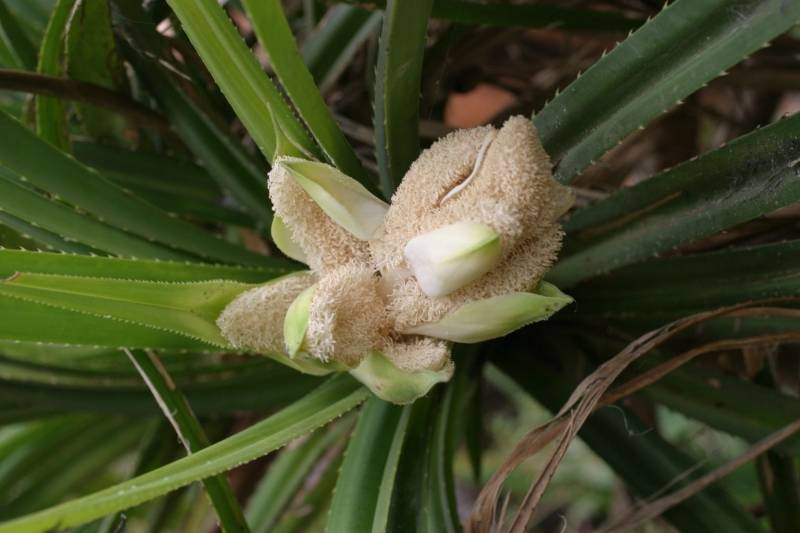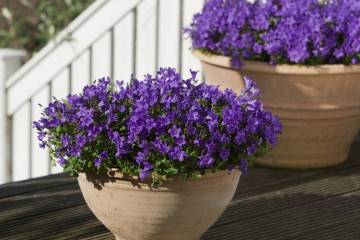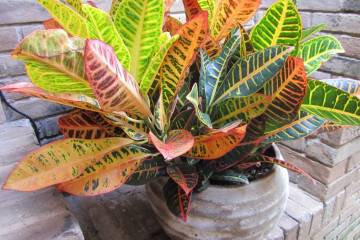Pandanus flower - what kind of houseplant?
Content:
The pandanus flower (Pandanus) is a member of the Panda family. To date, a little less than 800 species of this culture have been studied. Representatives of the family are widespread in the Eastern Hemisphere. This tree-like plant has the ability to adapt to various conditions. It can be found on river banks, in swampy areas and even in the mountains.
A short description of what it looks like
Long, narrow, thorny leaves give the flower a charm. They are located on the trunk in a spiral. Due to its resemblance to the foliage of a palm tree, it is called "spiral palm".
There are tree and shrub varieties. In their natural environment, they grow up to 4 meters. Over time, the tree begins to dry, and then the lower part of the trunk dies off, but the tree continues to live, relying on aerial roots.
Inflorescences are panicles of small yellowish or creamy flowers.
Pandanus species
Although the genus contains many species, a small number of them can grow at home. Taking care of pandanus at home is not difficult even for beginners.
Among the domestic varieties, the following can be noted.
Pandanus Veitch, or Veitch (Pandanus veitchii)
This species has a slightly shortened trunk. Aerial roots give it stability. The crown consists of long (about 1 m) and narrow (5-8 cm) leaves arranged in a spiral. The leaf blade is bordered with a white tint and the border is densely lined with light spines.
Veitch's pandanus grows up to 1.5 m and almost never blooms.
Pandanus utilis
A large plant that grows at home up to 3 m.It does not bloom at home and therefore does not grow. That is, for the entire period of growth, there is one trunk and one crown.
The leaves are dark green, long (up to 1.5 m), spiral-shaped along the trunk. The edge of the leaf is lined with pale red needles.
Pandanus sanderi
This type is distinguished by the coloring of the leaf plate. It has yellow stripes across the green field. The leaves themselves are up to 0.8 m long.
Covering Pandanus (Pandanus tectorius)
An evergreen branched plant that rests on stilted roots. The leaves are long, very pointed, covered with white thorns. Sometimes these pandas can bloom, but there are no fruits with room cultivation.
In their natural environment, they produce edible, tasty orange or yellow fruits. The medicinal benefits of consuming them have not been proven.
Blooming pandanus at home
At home, indoor pandanus flower, like a blooming flower, is almost never found. There is little information about this. Occasionally, a ramp that covers itself pleases with flowering. Flowers with a diameter of 0.5-1 cm, white or pink.
Pandanus - home care
Flower care has no seasonal differences. It is important to properly regulate the water-temperature regime and not forget about feeding.In any season, it can be transplanted / propagated.
Illumination and temperature conditions
The plant needs bright light all year round. With a lack of lighting, the leaves become lethargic, lose color. Only you should protect them from direct sunlight.
The optimal place for the pandanus is the western and eastern windows. With a lack of light, the plants are illuminated.
The optimum temperature for the crop is from +19 to +25 ° C. Without prejudice to decorativeness, it can also tolerate lower temperatures, but not lower than +12 ° C.
During the rest period, coolness is preferable, for example, + 15-19 ° C. Or the mode can be regulated by systematic ventilation of the room, but without drafts.
Watering rules and humidity
During the growing season, the plant should be watered abundantly, without waiting for the earthen coma to dry out. This can be once a day, or twice (as the surface layer dries out). After half an hour, the water must be drained from the pallet.
Do not spray the foliage. Drops of water in the axils of the leaves can provoke rotting of the leaf plate. And it is useful to wipe with a damp cloth, but only with gloves. There is a danger of pricking yourself with thorns.
Air humidity for the culture is normal. As in living quarters. But, with a strong drying out of the air, it is recommended to put the flower pot on a pallet with wet river sand (expanded clay, broken brick and foam crumbs).
Top dressing and soil quality
The pandanus palm prefers loose, nutritious soil. You can buy a store-bought soil for palm trees, or you can prepare the mixture yourself. Two or three components are enough. The third part of the mixture is sand, which is mixed with rotted foliage or humus and peat.
During the period of active growth (March-August), the plant needs feeding twice a month. For this, special mineral fertilizers for deciduous indoor crops are suitable. During the rest period, feeding is stopped.
Flower container size
For the pandanus, the characteristics of the flowerpot are very important. It is selected taking into account that 1/3 of the height will be occupied by drainage. This is a prerequisite. The diameter of the container is chosen 1.5-2 cm larger than that of the previous one.
Features of plant transplant
Young plants need replanting annually, and adults - once every 2-3 years. Deviations in the frequency of transplants depend on the growth of the root system.
The roots of the plant are very fragile and should be handled carefully. The crown of the tree, so as not to interfere with the work, needs to be raised and bandaged. Then carefully remove the bush from the pot and lower it into a new pot with a drainage layer, but without earth. Only then fill the voids between the walls of the flowerpot and the root ball with soil mixture.
Reproduction of helical palm
The pandanus screw palm reproduces in several main ways. Here's how the pandanus can be propagated:
- dividing the bush;
- cuttings;
- sowing seeds.
Cuttings
For grafting, the lateral shoots of the pandanus plant are used. The length of the handle must be at least 20 cm.
Places of cuts should be treated with crushed charcoal or cinnamon powder. Dried cuttings are planted in sand and peat soil, covered with glass / film. The container is exposed in a warm place. Planting needs regular watering and ventilation. The stalk takes root at the end of 1.5-2 months.
By dividing the bush
At the base of the trunk and in the axils of the leaves, rosette babies are formed. Slightly grown shoots, together with the roots, are separated from the parent plant, dried in the air for a day and planted in a separate container. Until complete rooting, it is better to cover the seedling with a jar.After a month, the jar can be removed.
Seeds
Seeds for seedlings are sown in a container with a soil mixture of peat sand (1: 1). Crops are sprayed from a spray bottle and covered with foil / glass. The mini greenhouse is transferred to a warm place. Before emergence, seedlings should be periodically moistened and ventilated.
The first shoots will appear in 2-4 weeks. When 2-3 leaves appear, the seedlings can be planted in individual pots.
Diseases and pests
Even high immunity does not save indoor pandanus from pests. He is especially loved by:
- Shields and false shields. The defeat can be recognized by the sticky dark scales on the leaf. The pest can be exterminated by treatment with Karbofos or Actellik.
- Mealybugs. Insects are first collected by hand and the tree is treated with anti-acaricidal medicine (Diklox, Tolkoks, Koktsigard).
- Spider mites. They leave visible punctures on the sheet. For treatment, agents such as Aktara, Aktellik are used.
Of the diseases, root rot can be noted. At the beginning of the disease, you can try to remove the spoiled areas of the roots, rinse in a pink solution of manganese and plant in fresh soil. Next, you should properly regulate watering.
The plant may turn yellow / shallow leaves. This is a purely human factor. This means that hard water was used for irrigation / there is not enough lighting / dry air in the room. Eliminating the causes will return the flower to its normal state.
Signs associated with pandanus
Some signs are associated with the pandanus. The properties of magic are also attributed to him. For example, it is believed that he can make the character of impressionable people overly suspicious. There is also an opinion that the plant sucks out the energy of the owners and transforms it into aggression. Because of this, not everyone decides to plant such a palm tree at home.
Pandanus as a houseplant is distinguished by its unpretentiousness. It can be kept in a room, it perfectly decorates winter gardens. Lack of lighting and insufficient watering by the plant is tolerated without much loss. The dimensions of an adult flower can cause inconvenience. Therefore, it is easier to keep young specimens at home.




















